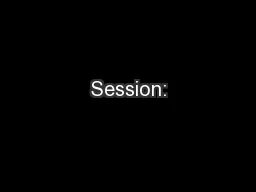

Connecting Slow Wind Theories to Current and Future Observations by Justin Edmondson Ben Lynch Aleida Higginson Xudong Sun and Liang Zhao Scene Setting Talk 1 Spiro Antiochos ID: 623959
Download Presentation The PPT/PDF document "Session:" is the property of its rightful owner. Permission is granted to download and print the materials on this web site for personal, non-commercial use only, and to display it on your personal computer provided you do not modify the materials and that you retain all copyright notices contained in the materials. By downloading content from our website, you accept the terms of this agreement.
Slide1
Session: Connecting Slow Wind Theories to Current and Future Observationsby Justin Edmondson, Ben Lynch, Aleida Higginson, Xudong Sun and Liang Zhao
Scene Setting Talk 1 – Spiro
Antiochos
“Slow Wind” Properties
Compositional resembles the closed-field corona
slower speeds
(but this is not the defining feature)
Strong
variation
in speed and especially
composition
Always surrounds the HCS but can have a spatial
extent up to 30 degrees away from HCS
Theories (Location! Location! Location!)
Expansion factor
–
the slow wind is coming from the open field lines at the edges of coronal holes (this is steady state!)
S-Web
–
the slow wind is coming from closed field lines which interchange at the edges of coronal holes (this is dynamic!)
Interchange
reconnection everywhere:
the slow wind is coming from closed field lines which interchange throughout the closed field corona (this is dynamic!) Slide2
Connecting Slow Wind Theories to Current and Future Observations Scene Setting Talk 2 – Joe BorovskyAt both helmet streamer and pseudo streamer crossingsThe transition from slow to fast wind there is an extremely sharp boundary between the speeds, proton entropy, and charge-state ratios, which all occur within a few minutes of each otherThe transition from fast to slow wind shows a much more gradual boundary, as expected in the rarefaction region BUT the alignment between the speed, charge-state, and entropy transition is much farther apart than you would expect from just rarefaction effects (10-15 hours). Slides Show: Yuan-Kuen
Ko
Low velocity
fluctuations
dip is a good marker to distinguish the slo
w wind from the fast wind
,
nearly all solar wind parameters (IMF, proton, electron, and heavy ions)
line
up
within this low velocity
fluctuation interval via super-epoch
analysis.
Happens
near
both
heliospheric
current sheet crossing
or pseudostreamer
crossings and have nearly identical properties
.Slide3
Connecting Slow Wind Theories to Current and Future Observations From the discussion, we determined the following specific questions for the upcoming missions.Remote sensingDo the elemental abundances observed by Solar Orbiter (SO) and Parker Solar Probe (PSP) change as a function of position across a coronal hole? How does the plasma variability measured by SO and PSP change as a function of angle from the center of the streamer stalk? Can we measure the boundary between the expansion factor “Slow
Wind
1”, and plasma sheet “Slow
Wind
2”.
How do coronal hole boundaries measured by SO change over time? On what time scales?
Can you see an S-Web arc with
heliospheric
imagers? What are the signatures?
In situ
Measure wind in S-Web arc and compare with predictions of quasi-steady models.
How does the magnetic field variability measured by SO and PSP change as a function of angle from the HCS? Especially inside 20 R
S
. Look for Slow 1
–
Slow 2 boundary.
Work closely with modelers to calculate signatures of interchange reconnection and test predictions along S-Web arcs.Slide4
Need modelers to make specific predictions for observable signatures that address the previous questions.Dedicated SHINE Campaign!! In order to answer these questions with PSP and SO, we need a coordinated effort to determine the connection of the magnetic field and the plasma back to the photosphere!Slide5
Expansion factor: Open field near coronal hole boundary; due to same quasi-steady process as fast windDynamic S-Web: Closed field near coronal hole boundary; due to dynamicsInterchange:
Theories for Slow
Wind Origins
Throughout closed field region; due to dynamics
Open-closed structure critical to all models – never simple dipoleSlide6
Helmet-Streamer Crossing
6
Crooker et al. 2014
♯
?Slide7
Pseudostreamer Crossing
7
Crooker et al. 2014
♯
?